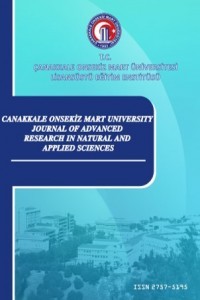Investigation and Comparison of Some Laboratories in Terms of Occupational Health and Safety by ELMERI Observation Method
Applicable safety elmeri method, laboratory safety, occupational health and safety, observation method,
___
- Aksoy, Ü., Özdemir, H., Usluca, S., & Toprak Ergönen, A. (2008). Biosafety profile of laboratory workers at three education hospitals in İzmir, Turkey. Bulletin of Microbiology, 42(3), 469-476.
- Atlı, B. (2018). Investigation of general occupational health and safety situation of five marble facto-ries using elmeri method (Master’s thesis). Retrieved from: https://tez.yok.gov.tr/UlusalTezMerkezi
- Çukurluöz, S., Birgören, B., Yalçınkaya, M., & Orçanlı, K. (2020). A new performance audit method-ology for 6S applications in lean manufacturing. International Journal of Engineering Research and Development, 12(2), 358-369. https://doi.org/10.29137/umagd.66819
- Dalyan, O., & Pişkin, M. (2020). The impact of near miss noticed on occupational accidents at work-places a study from construction. Çanakkale Onsekiz Mart University Journal of Science and Technology, 6(1), 133 – 143. DOI: https://doi.org/10.28979/comufbed.609675
- Derman, M., & Çakmak, M. (2016). Investigation of Biology students’ perception regarding laboratory safety. Bartın University Journal of Faculty of Education, 5(1), 178-187. https://doi.org/10.14686/buefad.v5i1.5000161902
- Dukich, K., Zoric, M., Pozaic, P., Stracic, J., Culjak, M., Saracevic, A., & Miler, M. (2015). How com-pliant are technicians with universal safety measures in medical laboratories in Croatia?-a pilot study. Biochemia Medica, 25(3), 386-392. https://doi.org/10.11613/BM.2015.038
- El-Ginay, A., El-Shaer, S., Khashaba, E., El-Dakroory, S., & Omar, N. (2017). Knowledge, attitude and practices (KAP) of “teaching laboratory” technicians towards laboratory safety and waste management: a pilot interventional study. The Journal of Hospital Infection, 96(2), 1-3. https://dx.doi.org/10.1016/j.jhin.2017.02.007
- Emerce, E., & Doğan, B. (2017). Knowledge and practices of pharmaceutical laboratory workers on laboratory safety. Turkish Journal of Public Health, 15(2), 106-122.
- Ergun, A., Karakaya, F., & Akkaş, A. (2011). Türkiye’de işyerlerinde iş sağlığı ve koşullarının iyileşti-rilmesi projesi (İSGİP). İş Sağlığı ve Güvenliği Dergisi, 11 (52), 58-59.
- Ersoy, S., & Çelenk Kaya, E. (2019). Bir kamu üniversitesi gıda mühendisliği laboratuvarları risk ana-lizi uygulaması. Gümüşhane University Journal of Health, 8(4), 411-423.
- İş Sağlığı ve Güvenliğine İlişkin İşyeri Tehlike Sınıfları Tebliği. (2012, 26 12). Resmî Gazete (Sayı: 28509). Retrieved from: Mevzuat Bilgi Sistemi
- Karabulut, M. (2016). Determination of ohs risks of employees in chemistry laboratories of universi-ties and solution suggestions for chemical exposure (Occupational Health and Safety Thesis). Retrieved from: meryemkarabulut.pdf (ailevecalisma.gov.tr)
- Kerimak Öner, M. (2020). Laboratory safety culture placement in chemistry education. İSG Academic, 2(1), 15-25.
- Laitinen, H., Vuorinen, M., Simola, A., & Yrjanheikki, E. (2013). Observation-based OHS outcome indicators-validity of elmeri+ method. Safety Science, 54, 69-79. https://doi.org/10.1016/j.ssci.2012.11.005
- Martı, D. (2016). Evaluation of dust and silica exposure in brick and tile production sector and deter-mining thermal comfort conditions (Occupational Health and Safety Thesis). Retrieved from: dogamarti.pdf (ailevecalisma.gov.tr)
- Nasim, S., Shahid, A., Mustufa, M., Kazmi, S., Siddiqui, T., Mohiuddin, S., Sheikh, M., & Usman, S. (2010). Practices and awareness regarding biosafety measures among laboratory technicians working in clinical laboratories in Karachi, Pakistan. Applied Biosafety Journal, 15(4), 172-179. https://doi.org/10.1177/153567601001500403
- Ongun, A. (2015). Occupational health and safety in Turkey and Finland’s manufacturing industry comparison and elmeri with OHS-YSD methods an application (Master’s thesis). Retrieved from: https://tez.yok.gov.tr/UlusalTezMerkezi
- Ongun, A., & Bilen, K. (2016). Analysis and an application of Elmeri Method. İş Sağlığı ve Güvenliği Genel Müdürlüğü (Eds.), 8. International conference on safety & health (pp. 574-583). İstanbul, Turkey. Retrieved from: untitled (ailevecalisma.gov.tr)
- OSHA. (2011). Laboratory Safety Guidance. U.S.: Occupational Safety and Health Administration U.S. Department of Labor. Retrieved from: Laboratory Safety Guidance (osha.gov)
- Özdemir, B. (2014). Evaluation of occupational health and safety conditions in textile ateliers by using multi-criteria decision-making method (Occupational Health and Safety Thesis). Retrieved from: burakozdemir.pdf (ailevecalisma.gov.tr)
- Shekhar, H., Patel, M., Jain, C., Garg, N., & Mangukiya, K. (2015). Awareness to hazards and biosafe-ty precautions among laboratory technicians working in tertiary-care center in Rajasthan, India. International Journal of Medical Science and Public Health, 4(1), 15-18.
- Vahapassi, A., Laitinen, H., Campbell, S., Ersan, E., Birgören, B., Özesen, M., Matisane, L., Şimşek, C., Atlı, K., Demirkol, D., & Rodoplu, S. (2012). KOBİ’ler için İş Sağlığı ve Güvenliği Yönetim Rehberi: Risk Değerlendirmesi, İSG Performans İzleme ve Sağlık Tehlikeleri-Metal Sektörü. Ankara: Çalışma ve Sosyal Güvenlik Bakanlığı. Retrieved from: Microsoft Word - Metal YENİ (ai-levecalisma.gov.tr)
- Yaylalı, Ç. (2016). The Elmeri Method of performance monitoring at occupational health and safety and an application in metal workshop of Karamanoğlu Mehmetbey University vocational school. Young Scholars Union (Eds.). II. International Multidisciplinary Congress of Eurasia (pp. 589-602). Odessa, Ukraine. Retrieved from: Önceki Kongreler (imcofe.org)
- Yılmaz, Ş., & Bilici, M. (2020). Occupational health and safety in laboratories located in the faculty of engineering. OHS Academy, 3(2), 102-113. DOI: https://doi.org/10.38213/ohsacademy.745723
- Zaveri, J. (2012). Knowledge, attitudes and practice of laboratory technicians regarding universal work precaution. National Journal of Medical Research, 2(1), 113-115.
- Yayın Aralığı: Yılda 4 Sayı
- Başlangıç: 2015
- Yayıncı: Çanakkale Onsekiz Mart Üniversitesi
Harun ÇİFTÇİ, Çiğdem ER ÇALIŞKAN, Kübra ÖZTÜRK
Sünek Betonarme Perde Duvarların Şekil değiştirme Esaslı Hasar Sınırları
Saeid FOROUGHİ, Bahadır YÜKSEL
Orkun DALYAN, Nuray ÖZKAYA, Mehmet PİŞKİN, Ömer Faruk ÖZTÜRK
Abdul Walid SALİK, Zafer COŞKUN, Mohammad Zaman AMİNİ
Formula Student Race Car Chassis Design and Analysis
Yiğit Alp OYMAK, Erol FEYZULLAHOĞLU
Ali UÇAR, Sevgi KARACA, Nezahat EDİZ, Oktay ŞAHBAZ, İsmail Göktay EDİZ
